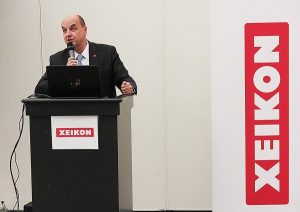Xeikon used the fifth Xeikon Café edition at the company’s production site near Antwerp, Belgium, to share its latest developments and to reveal a ‘tip of its strategy’ for Labelexpo and drupa 2020. Ron Augustin, our European editor for the past 30 years, reports on the event.

Photo PSA
While moderating its involvement in folding cartons, Xeikon intends to present ‘something in the area of corrugated’ at the latest by drupa 2020. For Labelexpo Europe later this year in Brussels, Xeikon has reserved its biggest stand ever; and, the space at drupa is also to be doubled. Emphasis will be on integrated prepress and order management workflows, an industrial entry-level label printing and converting package, a solution for standup pouches on the dry toner presses, new toner developments, a high-capacity version of the PX3000 inkjet press, and further improvements on the Thermoflexx range of flexo CtPs.
Sales turnover up by 15%
Xeikon’s takeover by the Flint Group five years ago resulted in an expansion course, which led to more aggressive targets and changing strategies. Half of the company’s business now consists of inkjet, while dry toner electrography remains the distinguishing technology in its latest label and flexible packaging developments. Overall sales turnover increased 15% last year, mainly due to growth in the USA and China. Production capacities at the company’s Global Innovation Centre are being ramped up, particularly for the Xeikon 3500 and CX500. Xeikon’s factory spaces have been enlarged and streamlined, a far cry from the early days when they rather resembled Q Branch in the James Bond movies. Much of that pioneer spirit has remained, however.
Own workflow and converting aided by partnerships
Xeikon presses are driven by the company’s own X-800 front-end, a workflow package including prepress and color management modules that are under constant development in collaboration with software company Hybrid, aimed at ‘zero-touch’ workflow processes. For order management, the company is partnering with MIS producers such as CERM and LabelTraxx, and does not intend to develop its own MIS. The system is also open to other software applications, be they from Adobe or Esko or others. Xeikon provides Color Services to help customers optimize and standardize their color reproduction, both with software applications and new consumables.
While continuing partnerships with a range of converting equipment suppliers present at this year’s Xeikon Café (such as ABG, Brotech, Cartes, GM, MGI, Rietstack, SEI and others), Xeikon also intends to expand its own converting portfolio. At Labelexpo Americas last year, the company had already introduced its entry-level Label Discovery Package consisting of an entry-level Xeikon 3030 press and the new EntryDcoat 330 converting line with semi-rotary diecutting, to be used inline or offline. Configurations based on the CX3 press are said to cover a majority of jobs on standard PP substrates and provide an option for PE.
Food safe toners for standup pouches
Dry-lamination and new toner developments for food safety are part of a solution for the production of standup pouches, with lower migration risks due to dry toner’s larger molecules. At the Xeikon Café, the high-end CX500 platform, with widths of 520 mm and speeds of up to 30 meters a minute, was used to showcase the production of pouches for CS Labels from the UK, who initiated this development. Food-safe toners used on a combination of paper and biodegradable PE are also enabling the sustainable production of paper cups.
High capacity PX3000 UV inkjet for standard substrates
On the inkjet-front, Xeikon announced the release of a high-capacity version of its PX3000 UV inkjet press, capable of printing on standard substrates. Ink optimization software including ink balance, white ink layering and tactile effects, as well as improved UV curing are part of these developments. Asked whether he expects inkjet to displace dry toner over the next one or two decades, Xeikon CEO Benoit Chatelard remarked that “people have been consistently wrong on toner, but if you read all the analyst’s projections for the next decade, they still see half of the digital printing technologies in toner. We think there are things inkjet doesn’t do that toner does and vice versa. In terms of value, inkjet doesn’t catch up with the value generation in toner. I would be ready to bet a million dollars that it’s not going to happen soon that toner would be out of business over the next one or two decades.”
Xeikon is also an important manufacturer of CtP systems. For its successful Thermoflexx flexo-CtPs, the company announced new features, such as automatic plate thickness detection, auto calibration and Woodpecker Nano surface screening for solid areas. The complete range of Thermoflexx CtPs will be on show both at Labelexpo in Brussels and drupa 2020 in Dusseldorf.











